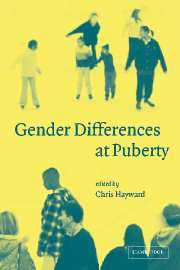Book contents
- Frontmatter
- Contents
- List of figures
- List of tables
- List of contributors
- Preface
- Acknowledgments
- 1 Methodological concerns in puberty-related research
- Part 1 Sex differences in hormones and their effect at puberty
- Part 2 Girls at puberty
- Part 3 Boys at puberty
- Part 4 Puberty and psychopathology
- 8 Puberty and depression
- 9 Puberty and schizophrenia
- Part 5 Pubertal timing: antecedents
- Part 6 Pubertal timing: consequences
- Part 7 Puberty and context
- Index
- References
9 - Puberty and schizophrenia
Published online by Cambridge University Press: 22 September 2009
- Frontmatter
- Contents
- List of figures
- List of tables
- List of contributors
- Preface
- Acknowledgments
- 1 Methodological concerns in puberty-related research
- Part 1 Sex differences in hormones and their effect at puberty
- Part 2 Girls at puberty
- Part 3 Boys at puberty
- Part 4 Puberty and psychopathology
- 8 Puberty and depression
- 9 Puberty and schizophrenia
- Part 5 Pubertal timing: antecedents
- Part 6 Pubertal timing: consequences
- Part 7 Puberty and context
- Index
- References
Summary
Clinical lore links puberty with the onset of schizophrenia, but few empirical studies exist to connect the two events. One hypothesis is that a central nervous system protective role for female hormones, especially estrogens, may underlie such a relationship. In this chapter we describe our own empirical observations, discuss possible interpretations, note the limitations of each, and suggest some directions for future research.
Schizophrenia
Schizophrenia is a major psychotic disorder that affects approximately one percent of the adult population worldwide (Warner and de Girolamo, 1995); the impact of the disease is considerable, for society and for the individual. In the United States, for example, patients with schizophrenia occupy approximately 25 percent of hospital beds (Eaton, 1991). For the individual, schizophrenia presents with symptoms that make all aspects of life difficult. Active psychotic symptoms include hallucinations in various sensory domains, mainly auditory. Also characteristic are delusions or false beliefs, usually of a persecutory nature. Schizophrenia often leaves thought, speech, and behavior disorganized. Perhaps more problematic are deficit or negative symptoms, such as apathy, lack of motivation, loss of previous pleasures and interests, and a tendency toward social isolation. Increasingly, investigators have recognized that even more fundamental symptoms are cognitive, such as attentional problems, memory problems, and difficulties with reasoning. Clinical presentations are heterogeneous; the exact constellation of symptoms varies among individuals, within individuals, and changes over time (Liddle, 1999).
- Type
- Chapter
- Information
- Gender Differences at Puberty , pp. 165 - 184Publisher: Cambridge University PressPrint publication year: 2003



